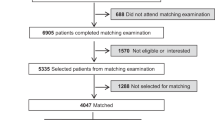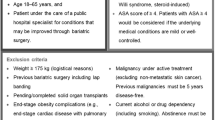Abstract
Despite its cardiometabolic benefits, bariatric surgery has historically been underused in patients with obesity and diabetes, but contemporary data are lacking. Among 1,520,182 patients evaluated from 2013 to 2019 within a multicenter, longitudinal, US registry of outpatients with diabetes, we found that 462,033 (30%) met eligibility for bariatric surgery. After a median follow-up of 854 days, 6310/384,859 patients (1.6%) underwent primary bariatric surgery, with a slight increase over time (0.38% per year [2013] to 0.68% per year [2018]). Patients who underwent bariatric surgery were more likely to be female (63% vs. 56%), white (87% vs. 82%), have higher body mass indices (42.1 ± 6.9 vs. 40.6 ± 5.9 kg/m2), and depression (23% vs. 14%; p < 0.001 for all). Over a median (IQR) follow-up after surgery of 722 days (364–993), patients who underwent bariatric surgery had lost an average of 11.8 ± 18.5 kg (23% of excess body weight), 10.2% were on fewer glucose-lowering medications, and 8.4% were on fewer antihypertensives. Despite bariatric surgery being safer and more accessible over the past two decades, less than one in fifty eligible patients with diabetes receive this therapy.
This is a preview of subscription content, access via your institution
Access options
Subscribe to this journal
Receive 12 print issues and online access
$259.00 per year
only $21.58 per issue
Buy this article
- Purchase on SpringerLink
- Instant access to full article PDF
Prices may be subject to local taxes which are calculated during checkout


Similar content being viewed by others
Data availability
The data that support the findings of this study are available from Veradigm upon reasonable request.
Code availability
Statistical analyses were performed using SAS version 9.4 software (SAS Institute, Inc., Cary, NC). Statistical code used to generate results available on request from authors.
References
Gregg EW, Jakicic JM, Blackburn G, Bloomquist P, Bray GA, Clark JM, et al. Association of the magnitude of weight loss and changes in physical fitness with long-term cardiovascular disease outcomes in overweight or obese people with type 2 diabetes: a post-hoc analysis of the Look AHEAD randomised clinical trial. Lancet Diabetes Endocrinol. 2016;4:913–21.
Rothberg AE, McEwen LN, Kraftson AT, Ajluni N, Fowler CE, Nay CK, et al. Impact of weight loss on waist circumference and the components of the metabolic syndrome. BMJ Open Diabetes Res Care. 2017;5:e000341.
Franz MJ, Boucher JL, Rutten-Ramos S, VanWormer JJ. Lifestyle weight-loss intervention outcomes in overweight and obese adults with type 2 diabetes: a systematic review and meta-analysis of randomized clinical trials. J Acad Nutr Diet. 2015;115:1447–63.
Van Gaal L, Scheen A. Weight management in type 2 diabetes: current and emerging approaches to treatment. Diabetes Care. 2015;38:1161–72.
Wilding JPH, Batterham RL, Calanna S, Davies M, Van Gaal LF, Lingvay I, et al. Once-weekly semaglutide in adults with overweight or obesity. N Engl J Med. 2021;384:989.
American Diabetes Association. Obesity management for the treatment of type 2 diabetes: standards of medical care in diabetes—2018. Diabetes Care 2018; 41(Supplement 1): S65–S72.
Schauer PR, Kashyap SR, Wolski K, Brethauer SA, Kirwan JP, Pothier CE, et al. Bariatric surgery versus intensive medical therapy in obese patients with diabetes. N Engl J Med. 2012;366:1567–76.
Schauer PR, Bhatt DL, Kirwan JP, Wolski K, Aminian A, Brethauer SA, et al. Bariatric surgery versus intensive medical therapy for diabetes—5-year outcomes. N Engl J Med. 2017;376:641–51.
Aminian A, Zajichek A, Arterburn DE, Wolski KE, Brethauer SA, Schauer PR, et al. Association of metabolic surgery with major adverse cardiovascular outcomes in patients with type 2 diabetes and obesity. JAMA. 2019;322:1271–82.
Sjöström L, Lindroos AK, Peltonen M, Torgerson J, Bouchard C, Carlsson B, et al. Lifestyle, diabetes, and cardiovascular risk factors 10 years after bariatric surgery. N Engl J Med. 2004;351:2683–93.
Martin M, Beekley A, Kjorstad R, Sebesta J. Socioeconomic disparities in eligibility and access to bariatric surgery: a national population-based analysis. Surg Obes Relat Dis. 2010;6:8–15.
Encinosa WE, Bernard DM, Steiner CA, Chen CC. Use and costs of bariatric surgery and prescription weight-loss medications. Health Aff. 2005;24:1039–46.
Campos GM, Khoraki J, Browning MG, Pessoa BM, Mazzini GS, Wolfe L. Changes in utilization of bariatric surgery in the United States From 1993 to 2016. Ann Surg. 2020;271:201–9.
American Diabetes Association. Obesity management for the treatment of type 2 diabetes. Diabetes Care. 2020;43:S89–S97. Suppl 1
Yumuk V, Tsigos C, Fried M, Schindler K, Busetto L, Micic D, et al. European guidelines for obesity management in adults. Obes Facts. 2015;8:402–24.
Ammori BJ, Skarulis MC, Soran H, Syed AA, Eledrisi M, Malik RA. Medical and surgical management of obesity and diabetes: what’s new? Diabetic Med. 2020;37:203–10.
Arnold SV, Inzucchi SE, McGuire DK, Mehta SN, Goyal A, Sperling LS, et al. Evaluating the quality of comprehensive cardiometabolic care for patients with type 2 diabetes in the U.S.: The Diabetes Collaborative Registry. Diabetes Care. 2016;39:e99–e101.
Mechanick JI, Youdim A, Jones DB, Garvey WT, Hurley DL, McMahon MM, et al. Clinical practice guidelines for the perioperative nutritional, metabolic, and nonsurgical support of the bariatric surgery patient—2013 update: cosponsored by American Association of Clinical Endocrinologists, The Obesity Society, and American Society for Metabolic & Bariatric Surgery. Obesity. 2013;21:S1–27. Suppl 1
Hsu WC, Araneta MR, Kanaya AM, Chiang JL, Fujimoto W. BMI cut points to identify at-risk Asian Americans for type 2 diabetes screening. Diabetes Care. 2015;38:150–8.
Mentias A, Aminian A, Youssef D, Pandey A, Menon V, Cho L, et al. Long-term cardiovascular outcomes after bariatric surgery in the medicare population. J Am Coll Cardiol. 2022;79:1429–37.
Wharton S, Serodio KJ, Kuk JL, Sivapalan N, Craik A, Aarts MA. Interest, views and perceived barriers to bariatric surgery in patients with morbid obesity. Clin Obes. 2016;6:154–60.
Gasoyan H, Tajeu G, Halpern MT, Sarwer DB. Reasons for underutilization of bariatric surgery: the role of insurance benefit design. Surg Obes Relat Dis. 2019;15:146–51.
Chhabra KR, Fan Z, Chao GF, Dimick JB, Telem DA. The role of commercial health insurance characteristics in bariatric surgery utilization. Ann Surg. 2021;273:1150–6.
Gasoyan H, Soans R, Ibrahim JK, Aaronson WE, Sarwer DB. Do insurance-mandated precertification criteria and insurance plan type determine the utilization of bariatric surgery among individuals with private insurance? Med Care. 2020;58:952–7.
Ward ZJ, Bleich SN, Cradock AL, Barrett JL, Giles CM, Flax C, et al. Projected U.S. state-level prevalence of adult obesity and severe obesity. N Engl J Med. 2019;381:2440–50.
Funding
VH, MBT, and RAG are supported by the National Heart, Lung, and Blood Institute of the National Institutes of Health (T32HL110837). DCR was previously funded by AstraZeneca and Boehringer Ingelheim and is currently managed by Veradigm. Corporate sponsors had no role in data analysis or interpretation, manuscript development, or in publication review or approval for this study.
Author information
Authors and Affiliations
Contributions
PJ: Conceptualization, Data Interpretation, Writing Original Draft; VH: Conceptualization, Methodology, Data Interpretation, Writing Original Draft; MBT: Methodology, Data Interpretation, Writing Review & Editing, Supervision; RAG: Data Interpretation, Writing Review & Editing, Supervision; KFK: Methodology, Formal analysis, Writing Review & Editing; AG: Data Interpretation, Writing Review & Editing; LS: Data Interpretation, Writing Review & Editing; SRD: Data Interpretation, Writing Review & Editing; SH: Data Interpretation, Writing Review & Editing; JRE: Data Interpretation, Writing Review & Editing, Supervision; SVA: Conceptualization, Methodology, Formal analysis, Data Interpretation, Writing Original Draft, Supervision.
Corresponding author
Ethics declarations
Competing interests
VH, MBT, and RAG, are supported by the National Heart, Lung, and Blood Institutes of Health Under Award Number T32HL110837; the content is solely the responsibility of the authors and does not necessarily represent the official views of the National Institutes of Health. The authors declare no competing interests.
Additional information
Publisher’s note Springer Nature remains neutral with regard to jurisdictional claims in published maps and institutional affiliations.
Rights and permissions
Springer Nature or its licensor holds exclusive rights to this article under a publishing agreement with the author(s) or other rightsholder(s); author self-archiving of the accepted manuscript version of this article is solely governed by the terms of such publishing agreement and applicable law.
About this article
Cite this article
Jain, P., Hejjaji, V., Thomas, M.B. et al. Use of primary bariatric surgery among patients with obesity and diabetes. Insights from the Diabetes Collaborative Registry. Int J Obes 46, 2163–2167 (2022). https://doi.org/10.1038/s41366-022-01217-w
Received:
Revised:
Accepted:
Published:
Issue date:
DOI: https://doi.org/10.1038/s41366-022-01217-w



